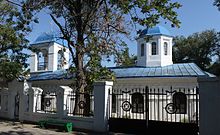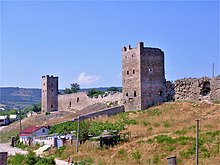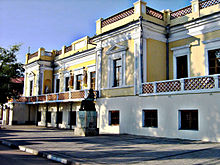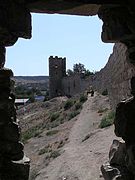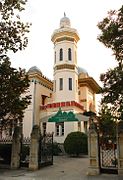Feodosia
| Feodosia | ||
| Феодосія | ||
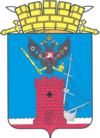
|
|
|
| Basic data | ||
|---|---|---|
| Oblast : | Autonomous Republic of Crimea | |
| Rajon : | District-free city | |
| Height : | 30 m | |
| Area : | 350 km² | |
| Residents : | 73,857 (2004) | |
| Population density : | 211 inhabitants per km² | |
| Postcodes : | 298100 | |
| Area code : | +380 6562 | |
| Geographic location : | 45 ° 2 ' N , 35 ° 23' E | |
| KOATUU : | 111600000 | |
| Administrative structure : | 1 city, 5 urban-type settlements , 11 villages | |
| Mayor : | Alexander Bartenew | |
| Address: | вул. Земська 4 98100 м. Феодосія |
|
| Statistical information | ||
|
|
||
Feodosiya (Ukrainian Феодосія , Russian Феодосия , both / Feodosija / ; Crimean Tatar Kefe ; ancient Greek Θεοδοσία Theodosia , medium Greek Κάφφας Kaffa , in the Middle Ages spread Kaffa or Caffa ) is a port city and a tourist center in the Autonomous Republic of Crimea ( Ukraine ) with about 90,000 inhabitants (with incorporated suburbs). Most of Feodosiya is inhabited by ethnic Russians .
Administrative division
From an administrative point of view, Feodosia is divided into:
- five urban-type settlements :
- Koktebel (Коктебель)
- Kurortne (Курортне)
- Ordzhonikidze (Орджонікідзе)
- Prymorskyj (Приморський)
- Shchebetovka (Щебетовка)
- and 11 villages:
- Berehove (Берегове)
- Blynye (Ближнє)
- Wynohradne (Виноградне)
- Krasnokamjanka (Краснокам'янка)
- Nanikowe (Нанікове)
- Nassypne (Насипне)
- Pid-brains (Підгірне)
- Pionerske (Піонерське)
- Sonjatschne (Сонячне)
- Stepowe (Степове)
- Yushne (Южне).
population
- Russians : 78,536 - 72.2%
- Ukrainians : 20,416 - 18.8%
- Crimean Tatars : 5055 - 4.6%
- Belarusians : 1949 - 1.8%
- Armenians : 557 - 0.5%
- Tatars : 236 - 0.2%
- Jews : 223 - 0.2%
- Moldovans : 184 - 0.2%
- Azerbaijanis : 167 - 0.2%
- Poland : 148 - 0.1%
- Georgians : 145 - 0.1%
- German : 117 - 0.1%
- Greeks : 109 - 0.1%
history
Antiquity
The city was founded in the sixth century BC. Founded by Greek colonists from Miletus as Theodosia and was ruled in chronological order by the following peoples: Greeks , Romans , Goths , Byzantines , Russians , Mongols ( Golden Horde ), Venetians , Genoese , Turks , Crimean Tatars .
The previously Greek city-state Theodosia belonged from 355 BC. To the Bosporan Empire , from 107 BC. To the kingdom of Pontus . After the Roman period from 63 BC BC, in which the city belonged to the Regnum Bospori , a vassal state of Rome as the successor to the Bosporan Empire, Theodosia was destroyed or sacked in the fourth century AD during the invasion of the Huns . But the Varangians also used the city to ship slaves.
middle Ages
In the fifth century the Alanen settlement Ardabda ("Seven Gods") was built here, which was destroyed again by the Khazars in the sixth century . From 1239, the Golden Horde ruled over the Crimea. After the Genoese received permission from the Khan of the Golden Horde to establish a settlement in the middle of the 13th century, they founded a colony in the settlement of Kafa , in Italian Caffa , near present-day Feodosia in 1266 . In 1307, however, the Golden Horde besieged the Genoese city. The Italians withstood the siege until 1308, then abandoned their city and burned it down.
The epidemic , known as the Black Death , probably took its European origin from what was then Kaffa in the Middle Ages , when infected Genoese refugees spread it along the trade routes of the Genoese colonies after a Mongolian siege in 1346/1347 . The Tatars , many of whom were infected by the plague, are said to have hurled corpses infected with the disease into the besieged city in order to force the city to be surrendered.
After the Mongols withdrew, the Genoese rebuilt the city. To protect against further sieges, two massive, concentric walls were built around the city. Until the middle of the 15th century, the Genoese had dominance over Caffa and in part the surrounding areas and larger sections of the Crimean coast, which they were largely able to maintain despite repeated military conflicts with the Tatar rulers.
During this time, the city gained increasing importance as a transshipment point for large parts of the Black Sea trade, which the Genoese, but also Venetians, Muslim and other merchants operated. The largest population group in the city were in the 11th – 18th centuries. Century Krimarmenier , remembered by numerous Armenian churches in the city and who were mostly active in long-distance trade, handicrafts and viticulture. This is also evidenced by the expansion of a trading port during this time. Extensive loads of various kinds of merchandise were brought from Caffa every year to the southern Black Sea, but also to the west towards Constantinople and further to Europe or the eastern Mediterranean (Egypt: sales of slaves from the Black Sea region were particularly high here). This flourishing Italian trade largely collapsed when, after the fall of Constantinople in 1453, the passage of the Bosporus as access to the Black Sea was no longer possible for Christian merchants, but was made possible by trade by the Crimean Khanate and Ottoman traders (Armenian, Tatar, Greek, Jewish including origin).
Modern times
In the following time the place belonged to the Ottoman Empire under the name Kefe (final capitulation in 1475, after tribute had to be paid to the Ottoman Sultan since 1455 ). From the 14th to the 17th centuries, the city hosted the largest slave market in Crimea, one of the largest in the entire region. In 1616, 1628 and 1667 there were repeated campaigns by the Zaporozhian Cossacks to Kefe to free Christian slaves.
In 1724 Prospero Lambertini, who later became Pope Benedict XIV , was titular archbishop ("archiepiscopus i [n] p [artibus] i [nfidelium]") of Theodosia. In 1783 the Crimea was annexed to the Russian Empire , and the city of Kefe was renamed Feodosia based on the old Greek name Theodosia.
In 1892 the place got a railway connection through the construction of today's Kherson – Kerch railway line .
After the October Revolution , it became part of the ASSR of Crimea within the Russian SFSR .
Second World War
After the German Wehrmacht conquered the city on November 3, 1941, the Jewish population of Feodossia was asked by members of Sonderkommando 10b (SS-Sturmbannführer Alois Persterer ) of Einsatzgruppe D under the leadership of Otto Ohlendorf to register. On December 1, 1941, the "resettlement", internment in a ghetto, of the Jewish and Crimean Chak inhabitants of the city took place. Three days later, on December 4, 1941, large parts of the Jewish population along with Crimchaks , Gypsies and alleged communists were murdered by the special command , which was carried out by the rear services of the 11th Army (Colonel General Erich von Manstein ), especially the local commandant's office II 915 and the Feldgendarmerie - department of the Feldkommandantur 810 (Feldgendarmerie-Leutnant Karl Rudolf Pallmann) was actively supported.
Of the 3,248 Jews who lived in Feodosiya before the German attack on the Soviet Union , 2,000 to 2,500 had been murdered by the end of 1941. According to a report to the Reich Security Main Office , between November 16, 1941 and December 15, 1941, a total of 17,645 Jews, 2503 Crimean chaks, 824 gypsies and 212 alleged communists were shot in the deployment area of Einsatzgruppe D (the entire Crimea).
When the city was briefly liberated by the Red Army during the Kerch-Feodosia operation , the discovery of the mass graves led to attacks on German soldiers and collaborators. According to the findings of the German Wehrmacht investigation center u. a. About 160 patients left behind in the German main hospital there were killed by members of the Soviet armed forces. After the city was retaken by the Wehrmacht, Red Army soldiers and those Jews who had been able to hide during the first occupation were blamed for this and murdered. In the course of a new Soviet offensive , the city was finally liberated in April 1944.
Development until today
By resolution of the Supreme Soviet of the USSR on the occasion of the 300th anniversary of the Treaty of Pereyaslav , Feodosiya and the Crimea Oblast were annexed to the Ukrainian Soviet Socialist Republic on April 26, 1954 . From 1991 to 2014 Feodosia was part of independent Ukraine.
Since the internationally unrecognized annexation of the Crimean peninsula to Russia in March 2014, Feodosia has de facto belonged to the federal subject of Southern Russia of the Russian Federation. De jure, according to the administrative-territorial division of Ukraine, Feodosia is part of the Autonomous Republic of Crimea , which is one of the territories occupied by Russia.
Feodosiya today
Feodosia has around 75,000 inhabitants today, most of them Russians , but also Ukrainians and in recent years some Crimean Tatars who were deported by Stalin during the 1940s and have now returned. As in many cities in eastern Ukraine, Russian dominates everyday life.
Feodosia is also a popular destination for tourists, especially those from the successor states of the Soviet Union . In the summer there are many thousands of tourists in the city. However, many cafes and hotels are closed in winter. In the coastal city there are numerous baths and wellness facilities, bathing beaches and also a lively cultural offer with cinemas and art galleries. Numerous concerts and exhibitions take place during the summer months. Viticulture is also practiced in the Feodosia area . Due to the Crimean Tatar past, there are also some mosques in the city.
Well-known sights are u. a.
- Remains of a Genoese fortress from the 14th and 15th centuries;
- an Orthodox church from the eighth to ninth centuries, which is also the oldest building in the city;
- Museum of the Russian painter Ivan Aivazovsky , who lived his life in the city;
- a Romanesque church from the twelfth century, in which the tomb of Ivan Aivazovsky is located.
Personalities
- Benedict XIV (1675–1758), titular archbishop of Theodosia
- Alexander Kasnatschejew (1788–1880), city commander around 1830
- Gawriil Aivazovsky (1812–1879), Russian orientalist of Armenian descent, brother of the above
- Ivan Aivazovsky (1817–1900), Russian marine painter of Armenian descent
- Lev Lagorio (1828–1905), Russian painter
- Anton Chekhov (1860–1904), Russian writer
- Konstantin Bogajewski (1872–1943), Russian painter
- Maximilian Woloschin (1877–1932), writer and painter
- Alexander Grin (1880–1932), Russian writer
- Boris de Fast (1890– after 1966), Russian-French actor, film editor, screenwriter and make-up artist
- Tolia Nikiprowetzky (1916–1997), Russian composer
- Natalja Malysheva (1921–2012), Soviet missile technician
- Harry Maier (1934-2010), German economist and university professor
- Tatjana Bösl (* 1971), German artist
- Serhiy Derevianchenko (* 1985), Ukrainian boxer
- Oleksandr Kratow (* 1985), Ukrainian orienteer
Picture gallery
literature
- Viktor F. Gajdukevič : The Bosporan Empire. 2nd edition, Akademie-Verlag, Berlin 1971 (on ancient history).
- Michel Balard : Caffa . In: Lexicon of the Middle Ages (LexMA). Volume 2, Artemis & Winkler, Munich / Zurich 1983, ISBN 3-7608-8902-6 , Sp. 1370 f.
- Sergej P. Karpov : La navigazione veneziana nel Mar Nero. XIII - XV sec.Edizioni del Girasole, Ravenna 2000, ISBN 88-7567-359-4 .
- J. Vincey: My Feodossia. Books on Demand, Norderstedt 2005, ISBN 3-8334-3340-X .
Web links
- official website of the city administration (ukrain.)
- History, exhibition, impressions and objects of the National Picture Gallery Feodosia "IK Aivazovsky"
Individual evidence
- ↑ Archive link ( Memento of the original from April 10, 2014 in the Internet Archive ) Info: The archive link was inserted automatically and has not yet been checked. Please check the original and archive link according to the instructions and then remove this notice.
- ^ William Bernstein : A Splendid Exchange. How trade shaped the world. Atlantic Books, London 2009, ISBN 978-1-84354-803-4 , p. 130.
- ↑ Nicolai Guleke : War Surgery and War Surgeons through the Ages. Gustav Fischer, Jena 1945, p. 5
- ^ Eberhard Jäckel , Peter Longerich , Julius H. Schoeps (ed.): Enzyklopädie des Holocaust . The persecution and murder of the European Jews. Argon, Berlin 1993, ISBN 3-87024-300-7 , sv Krim.
- ^ Norbert Kurz: The Crimea under German rule (1941-1944). Germanization utopia and the reality of occupation (= publications by the Ludwigsburg Research Center of the University of Stuttgart. Vol. 5). Edited by Klaus-Michael Mallmann . Wissenschaftliche Buchgesellschaft, Darmstadt 2005, ISBN 3-534-18813-6 , pp. 200-201 (also: Mainz, University, dissertation, 2003).
- ^ Martin Gilbert : The Routledge Atlas of the Holocaust. 3rd edition. Routledge, London a. a. 2002, ISBN 0-415-28146-6 , pp. 64, 83.
- ↑ Shmuel Spector , Geoffrey Wigoder (Ed.): The Encyclopedia of Jewish Life Before and During the Holocaust. Foreword by Elie Wiesel . New York University Press, New York NY 2001, ISBN 0-8147-9356-8 , sv Theodosia.
- ↑ Einsatzgruppe D, incident report No. 150 of January 2, 1942, quoted in: Helmut Krausnick , Hans-Heinrich Wilhelm : Die Truppe des Weltanschauungskrieges. The Einsatzgruppen of the Security Police and SD 1938–1942 (= sources and representations on contemporary history. Vol. 22). Deutsche Verlags-Anstalt, Stuttgart 1981, ISBN 3-421-01987-8 , p. 424 and p. 494.
- ↑ Alfred M. de Zayas : The Wehrmacht investigation center. Documentation of Allied war crimes in World War II. 7th expanded edition. Universitas / Langen-Müller, Munich 2001, ISBN 3-8004-1051-6 , pp. 308-317, chapter 19.
- ^ Norbert Kurz: The Crimea under German rule (1941-1944). Germanization utopia and the reality of occupation (= publications by the Ludwigsburg Research Center of the University of Stuttgart. Vol. 5). Edited by Klaus-Michael Mallmann. Wissenschaftliche Buchgesellschaft, Darmstadt 2005, ISBN 3-534-18813-6 , p. 201 (at the same time: Mainz, University, dissertation, 2003).
- ↑ Report by Major Teichmann, local commander Feodosia to Korück 553 of February 28, 1942 cited in: Marcel Stein: Field Marshal Von Manstein, A Portrait. The Janus Head. Helion & Co., Solihull 2007, ISBN 978-1-906033-02-6 , p. 372.
- ↑ The Transfer of the Crimea to the Ukraine (English)
- ↑ Федеральный закон Российской Федерации от 21 марта 2014 года № 6-ФКЗ "О принятии в Российскую Федерацию Республики Крым и образовании в составе Российской Федерации новых субъектов - Республики Крым и города федерального значения Севастополя"
- ↑ Annexation of the Crimea. Putin violates Russian constitution



